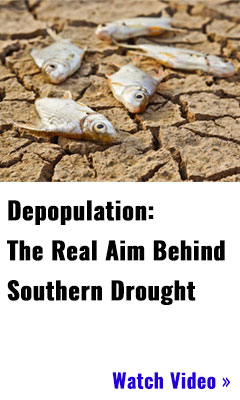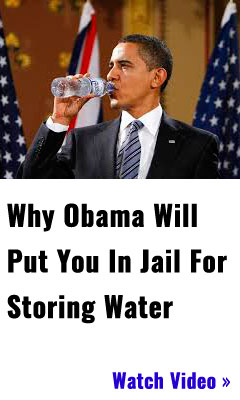TWENTY-FOUR METHODS TO PURIFY WATER
Water is the most crucial element for staying alive. It’s more important than food.
Everyone must have enough safe drinking water, which generally means one gallon per person per day. Needs will differ according to age, physical condition, lifestyle and climate.
This doesn’t include water for cooking, bathing, washing dishes and clothes, and pets or other animals. Large dogs may need as much as a gallon a day, while cats can do well with just a pint a day. If you have other livestock your water needs obviously soar. But in that case, water taken directly from a river or stream, without purification, will probably be okay.
Untreated water straight from the tap should keep for six months when stored in clean, durable containers. However, it must be changed periodically. Bacteria-free water, which means treatment with bleach or other compounds, will keep up to several years. Heat, light, deterioration of the container and other factors can cut this figure substantially.
Water should be stored as far as possible from paint and petroleum-based products, acids or anything with strong odors such as fertilizer or common household cleaning solutions. Lower-grade containers are permeable to certain gases and should be avoided whenever possible.
You’ll need to locate at least one other water source, since even several hundred gallons of stored water won’t last long. Assume any water not stored or purchased is contaminated, especially in perilous or unstable times. A mountain stream could look pristine, but still be polluted.
If you can find only marginal water, first strain the debris through a paper towel, clean cloth or coffee filter, then use one of the following methods:
SEPARATION: HEAT, LIGHT & GRAVITY
SEDIMENTATION gravitationally settles heavy suspended material.
BOILING WATER for 15 to 20 minutes kills 99.9% of all living things and vaporizes most chemicals. Minerals, metals, solids and the contamination from the cooking container become more concentrated.
DISTILLATION boils and recondenses the water, but many chemicals vaporize and recondense in concentration in the output water. It is also expensive to boil & cool water.
ULTRAVIOLET LIGHT is a good bactericide, but has no residual kill, and works only in clearly filtered water. Still in its infancy stage is a new technology involving super white light.
CHEMICALS
CHLORINE is common, cheap, but extremely toxic. It does not decrease physical or chemical contamination, it does increase colesterol formations, is a carcinogen, and causes heart disease.
BROMINE, used in pools and spas, doesn’t smell or taste as bad and doesn’t kill bacteria very well.
IODINE is not practical, and is mostly used by campers.
HYDROGEN PEROXIDE kills bacteria with oxygen, is chemically made and is very toxic. It is used in emergencies.
SILVER is an effective bactericide but a cumulative poison which concentrates and doesn’t evaporate.
NONTOXIC ORGANIC ACIDS should be used with caution in large water plants only.
LIME AND MILD ALKALINE AGENTS should also be used with caution only by large water plants, or only for laundry.
NEUTRALIZING CHEMICALS react with the unwanted chemicals and produce outgases and a sediment, but levels of need vary.
COAGULATION-FLOCCULATION adds chemicals which lump together suspended particles for filtration or separation.
ION EXCHANGE exchanges sodium from salt for calcium or magnesium, using either glauconite (greensand), precipitated synthetic organic resins, or gel zeolite, thus softening the water. Minerals, metals, chemicals or odors are not affected, and the water is salty to drink.
FILTRATION
SLOW SAND of 1 cubic meter passes about 2 liters/min, and does a limited bacteria removal.
PRESSURE SAND of 1 cubic meter passes about 40gpm and must be backwashed daily.
DIATOMACEOUS EARTH removes small suspended particles at high flow rates, must be daily backwashed and is expensive.
POROUS STONE/CERAMIC filters are small but expensive, and do not effect chemicals, bacteria or odors.
PAPER or CLOTH filters are disposable and filter to one micron, but do not have much capacity.
CHARCOAL:
–COMPRESSED CHARCOAL/CARBON BLOCK is the best type of charcoal filter, can remove chemicals and lead, but is easily clogged, so should be used with a sediment prefilter.
–GRANULAR CHARCOAL is cheaper, but water can flow around the granules without being treated.
-POWDERED CHARCOAL is a very fine dust useful for spot cleaning larger bodies of water, but is messy and can pass through some filters and be consumed.
REVERSE OSMOSIS uses a membrane with microscopic holes that require 4 to 8 times the volume of water processed to wash it in order to remove minerals and salt, but not necessarily chemicals and bacteria.
ENZYMES & BACTERIA combined can remove contaminants and reduce sludge. See recent article on enzymes & bacteria.
OXYDATION
AERATION sprays water into the air to raise the oxygen content, to break down odors, and to balance the dissolved gases. However, it takes space, is expensive, and picks up contaminants from the air.
OZONE is a very good bactericide, using highly charged oxygen molecules to kill microorganisms on contact, and to ozidize and flocculate iron, manganese and other dissolved minerals for post-filtration and backwashing.
ELECTRONIC PURIFICATION and DISSOLVED OXYGEN GENERATION creates super oxygenated water in a dissolved state that lowers the surface tension of the water and effectively treats all three types of contamination: physical, chemical and biological.
Other useful resources:
Survival MD (Best Post Collapse First Aid Survival Guide Ever)
Backyard Innovator (A Self Sustaining Source Of Fresh Meat,Vegetables And Clean Drinking Water)
Blackout USA (EMP survival and preparedness)
Conquering the coming collapse (Financial advice and preparedness )
Liberty Generator (Build and make your own energy source)
Backyard Liberty (Easy and cheap DIY Aquaponic system to grow your organic and living food bank)
Bullet Proof Home (A Prepper’s Guide in Safeguarding a Home )
Family Self Defense (Best Self Defense Strategies For You And Your Family)
Sold Out After Crisis (Best 37 Items To Hoard For A Long Term Crisis)
Survive The End Days (Biggest Cover Up Of Our President)
SOURCE : www.enviroalternatives.com


